Hybrid Fuzzy-Analytic Hierarchy Process (AHP) Model for Porphyry Copper Prospecting in Simorgh Area, Eastern Lut Block of Iran
Abstract
1. Introduction
2. Geology of the Study Area
3. Data and Methodology
3.1. Remote Sensing Data Characteristics
3.2. Preprocessing
3.3. Image Processing Techniques
3.4. Fuzzy-AHP Model
- (1)
- Determining criteria and sub-criteria for using in the model.
- (2)
- Determining the weight of criteria and sub-criteria using AHP model.
- (3)
- Fuzzification of information layers using fuzzy logic.
- (4)
- Integration of fuzzified layers, using the weights calculated in step 2.
4. Results and Discussion
4.1. False Color Combination (FCC)
4.2. Principal Component Analysis (PCA)
4.3. Minimum Noise Fraction (MNF)
4.4. Integration of Geological and Alteration Layers
4.5. Field Verification
5. Conclusions
Author Contributions
Funding
Data Availability Statement
Conflicts of Interest
References
- Beygi, S.; Talovina, I.V.; Tadayon, M.; Pour, A.B. Alteration and structural features mapping in Kacho-Mesqal zone, Central Iran using ASTER remote sensing data for porphyry copper exploration. Int. J. Image Data Fusion 2021, 12, 155–175. [Google Scholar] [CrossRef]
- Rowan, L.C.; Hook, S.J.; Abrams, M.J.; Mars, J.C. Mapping hydrothermally altered rocks at Cuprite, Nevada, using the Advanced Spaceborne Thermal Emission and Reflection Radiometer (ASTER), a new satellite-imaging system. Econ. Geol. 2003, 98, 1019–1027. [Google Scholar] [CrossRef]
- Shirazi, A.; Shirazy, A.; Karami, J. Remote sensing to identify copper alterations and promising regions, Sarbishe, South Khorasan, Iran. Int. J. Geol. Earth Sci. 2018, 4, 36–52. [Google Scholar]
- Mbianya, G.N.; Ngnotue, T.; Wambo, J.D.T.; Ganno, S.; Pour, A.B.; Kenne, P.A.; Fossi, D.H.; Wolf, I.D. Remote sensing satellite-based structural/alteration mapping for gold exploration in the Ketté goldfield, Eastern Cameroon. J. Afr. Earth Sci. 2021, 184, 104386. [Google Scholar] [CrossRef]
- Pour, A.B.; Hashim, M. The application of ASTER remote sensing data to porphyry copper and epithermal gold deposits. Ore Geol. Rev. 2012, 44, 1–9. [Google Scholar] [CrossRef]
- Moradpour, H.; Paydar, G.R.; Feizizadeh, B.; Blaschke, T.; Pour, A.B.; Kamran, K.V.; Muslim, A.M.; Hossain, M.S. Fusion of ASTER satellite imagery, geochemical and geology data for gold prospecting in the Astaneh granite intrusive, West Central Iran. Int. J. Image Data Fusion 2021, 1–24. [Google Scholar] [CrossRef]
- Hunt, G.R.; Ashley, R.P. Spectra of altered rocks in the visible and near infrared. Econ. Geol. 1979, 74, 1613–1629. [Google Scholar] [CrossRef]
- Shirazy, A.; Shirazi, A.; Ferdossi, M.H.; Ziaii, M. Geochemical and Geostatistical Studies for Estimating Gold Grade in Tarq Prospect Area by K-Means Clustering Method. Open J. Geol. 2019, 09, 306–326. [Google Scholar] [CrossRef]
- Alahgholi, S.; Shirazy, A.; Shirazi, A. Geostatistical Studies and Anomalous Elements Detection, Bardaskan Area, Iran. Open J. Geol. 2018, 8, 697–710. [Google Scholar] [CrossRef][Green Version]
- Zhang, N.; Zhou, K.; Du, X. Application of fuzzy logic and fuzzy AHP to mineral prospectivity mapping of porphyry and hydrothermal vein copper deposits in the Dananhu-Tousuquan island arc, Xinjiang, NW China. J. Afr. Earth Sci. 2017, 128, 84–96. [Google Scholar] [CrossRef]
- Ghezelbash, R.; Maghsoudi, A.; Daviran, M. Implementation of Fuzzy-AHP and Fuzzy-GAMMA approaches for discovering the prospectivity areas of Au mineralization in Takhte-Soleyman district. Res. Earth Sci. 2019, 10, 143–162. [Google Scholar] [CrossRef]
- Khalifani, F.; Bahroudi, A.; Barak, S.; Abedi, M. An integrated Fuzzy AHP-VIKOR method for Gold Potential Mapping in Saqez prospecting zone, Iran. Earth Obs. Geomat. Eng. 2019, 3, 21–33. [Google Scholar]
- Berberian, M.; King, G.C.P. Towards a paleogeography and tectonic evolution of Iran. Can. J. Earth Sci. 1981, 18, 210–265. [Google Scholar] [CrossRef]
- Ghorbani, M. Geological Setting and Crustal Structure of Iran. In The Geology of Iran: Tectonic, Magmatism and Metamorphism; Springer: Berlin/Heidelberg, Germany, 2021; pp. 1–22. [Google Scholar] [CrossRef]
- Borabadi, R.; Mazaheri, S.; Karimpour, M. Geology, alteration, mineralization and geochemical exploration in Simorgh prospective area, southwest of Nehbandan, South Khorasan. Iran. J. Crystallogr. Mineral. 2015, 4, 625–638. [Google Scholar]
- Karjoo. Report on the End of the Semi-Detailed Exploration Phase (Deh-Salm Region); GSI: South Khorasan, Iran, 2014; p. 140. [Google Scholar]
- Ahmadi, H.; Kalkan, K. Mapping of Ophiolitic Complex in Logar and Surrounding Areas (SE Afghanistan) With ASTER Data. J. Indian Soc. Remote Sens. 2021, 49, 1271–1284. [Google Scholar] [CrossRef]
- Shirazy, A.; Shirazi, A.; Laki, S.H.; Ziaii, M. Exploratory Remote Sensing Studies to Determine the Mineralization Zones around the Zarshuran Gold Mine. Int. J. Sci. Eng. Appl. 2018, 7, 274–279. [Google Scholar] [CrossRef]
- Ahmadi, H.; Rahmani, A.B. Study on The Mineral Anomalies Of Muqur-Chaman Fault And Its Comparison With Harirud (Herat) Fault (Afghanistan) Using Geophysical And Remote Sensing (Aster-Hymap) Data. Геoлoгия И Охрана Недр 2018, 1, 28–38. [Google Scholar]
- Crosta, A.; Filho, C.R.S.; Azevedo, F.; Brodie, C. Targeting key alteration minerals in epithermal deposits in Patagonia, Argentina, using ASTER imagery and principal component analysis. Int. J. Remote Sens. 2003, 24, 4233–4240. [Google Scholar] [CrossRef]
- Di Tommaso, I.; Rubinstein, N. Hydrothermal alteration mapping using ASTER data in the Infiernillo porphyry deposit, Argentina. Ore Geol. Rev. 2007, 32, 275–290. [Google Scholar] [CrossRef]
- Shirazi, A.; Hezarkhani, A.; Shirazy, A. Remote Sensing Studies for Mapping of Iron Oxide Regions, South of Kerman, Iran. Int. J. Sci. Eng. Appl. 2018, 7, 045–051. [Google Scholar] [CrossRef]
- Shirazy, A.; Ziaii, M.; Hezarkhani, A.; Timkin, T. Geostatistical and Remote Sensing Studies to Identify High Metallogenic Potential Regions in the Kivi Area of Iran. Minerals 2020, 10, 869. [Google Scholar] [CrossRef]
- Hamimi, Z.; Hagag, W.; Kamh, S.; El-Araby, A. Application of remote-sensing techniques in geological and structural mapping of Atalla Shear Zone and Environs, Central Eastern Desert, Egypt. Arab. J. Geosci. 2020, 13, 1–27. [Google Scholar] [CrossRef]
- Guha, A.; Ghosh, U.K.; Sinha, J.; Pour, A.B.; Bhaisal, R.; Chatterjee, S.; Baranval, N.K.; Rani, N.; Kumar, K.V.; Rao, P.V.N. Potentials of Airborne Hyperspectral AVIRIS-NG Data in the Exploration of Base Metal Deposit—A Study in the Parts of Bhilwara, Rajasthan. Remote Sens. 2021, 13, 2101. [Google Scholar] [CrossRef]
- Shirazi, A.; Hezarkhani, A.; Shirazy, A. Exploration Geochemistry Data-Application for Cu Anomaly Separation Based On Classical and Modern Statistical Methods in South Khorasan, Iran. Int. J. Sci. Eng. Appl. 2018, 7, 039–044. [Google Scholar] [CrossRef]
- Uddin, M.P.; Mamun, M.A.; Hossain, M.A. PCA-based feature reduction for hyperspectral remote sensing image classification. IETE Tech. Rev. 2021, 38, 377–396. [Google Scholar] [CrossRef]
- Ghrefat, H.; Kahal, A.Y.; Abdelrahman, K.; Alfaifi, H.J.; Qaysi, S. Utilization of multispectral landsat-8 remote sensing data for lithological mapping of southwestern Saudi Arabia. J. King Saud Univ.-Sci. 2021, 33, 101414. [Google Scholar] [CrossRef]
- Abdelkareem, M.; Hamimi, Z.; El-Bialy, M.Z.; Khamis, H.; Wahed, S.A.A. Integration of remote-sensing data for mapping lithological and structural features in the Esh El-Mallaha area, west Gulf of Suez, Egypt. Arab. J. Geosci. 2021, 14, 1–14. [Google Scholar] [CrossRef]
- Guha, A.; Kumar, K.V.; Rao, E.N.D.; Parveen, R. An image processing approach for converging ASTER-derived spectral maps for mapping Kolhan limestone, Jharkhand, India. Curr. Sci. 2014, 40–49. Available online: https://www.jstor.org/stable/24099861 (accessed on 10 October 2021).
- Chang, D.-Y. Applications of the extent analysis method on fuzzy AHP. Eur. J. Oper. Res. 1996, 95, 649–655. [Google Scholar] [CrossRef]
- Azizi, H.; Tarverdi, M.; Akbarpour, A. Extraction of hydrothermal alterations from ASTER SWIR data from east Zanjan, northern Iran. Adv. Space Res. 2010, 46, 99–109. [Google Scholar] [CrossRef]
- Mars, J.C.; Rowan, L.C. Spectral assessment of new ASTER SWIR surface reflectance data products for spectroscopic mapping of rocks and minerals. Remote Sens. Environ. 2010, 114, 2011–2025. [Google Scholar] [CrossRef]
- Rajan Girija, R.; Mayappan, S. Mapping of mineral resources and lithological units: A review of remote sensing techniques. Int. J. Image Data Fusion 2019, 10, 79–106. [Google Scholar] [CrossRef]
- Shirazy, A.; Hezarkhani, A.; Timkin, T.; Shirazi, A. Investigation of Magneto-/Radio-Metric Behavior in Order to Identify an Estimator Model Using K-Means Clustering and Artificial Neural Network (ANN) (Iron Ore Deposit, Yazd, IRAN). Minerals 2021, 11, 1304. [Google Scholar] [CrossRef]
- Shirazy, A.; Shirazi, A.; Hezarkhani, A. Predicting gold grade in Tarq 1: 100000 geochemical map using the behavior of gold, Arsenic and Antimony by K-means method. J. Miner. Resour. Eng. 2018, 2, 11–23. [Google Scholar]
- Doodran, R.J.; Khakmardan, S.; Shirazi, A.; Shirazy, A. Minimalization of Ash from Iranian Gilsonite by Froth Flotation. J. Miner. Mater. Charact. Eng. 2020, 9, 1–13. [Google Scholar] [CrossRef]
- Khayer, K.; Shirazy, A.; Shirazi, A. Permeability Estimation from Stoneley Waves in Carbonate Reservoirs. Türkiye Jeol. Bülteni 2022, 65, 1–8. [Google Scholar] [CrossRef]
- Shirazi, A.; Shirazy, A.; Nazerian, H.; Khakmardan, S. Geochemical and Behavioral Modeling of Phosphorus and Sulfur as Deleterious Elements of Iron Ore to Be Used in Geometallurgical Studies, Sheytoor Iron Ore, Iran. Open J. Geol. 2021, 11, 596–620. [Google Scholar] [CrossRef]
- Shirazy, A.; Shirazi, A.; Nazerian, H. Application of Remote Sensing in Earth Sciences–A Review. Int. J. Sci. Eng. Appl. 2021, 10, 45–51. [Google Scholar]
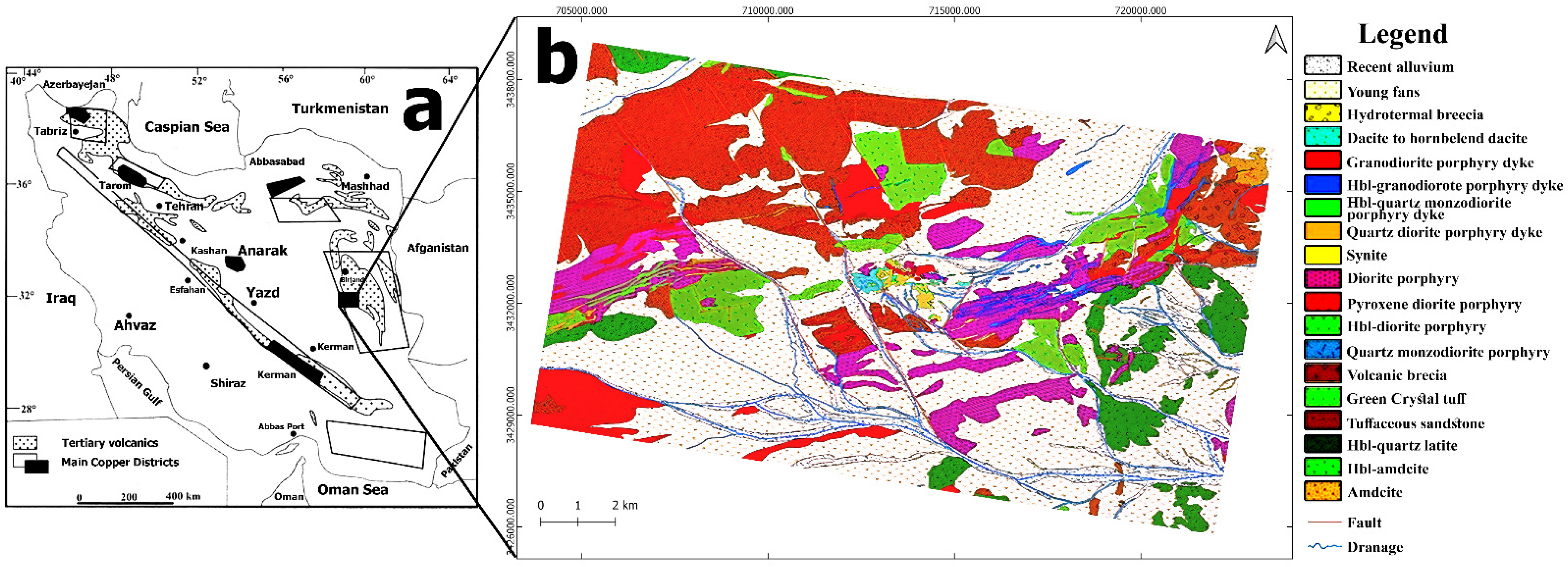
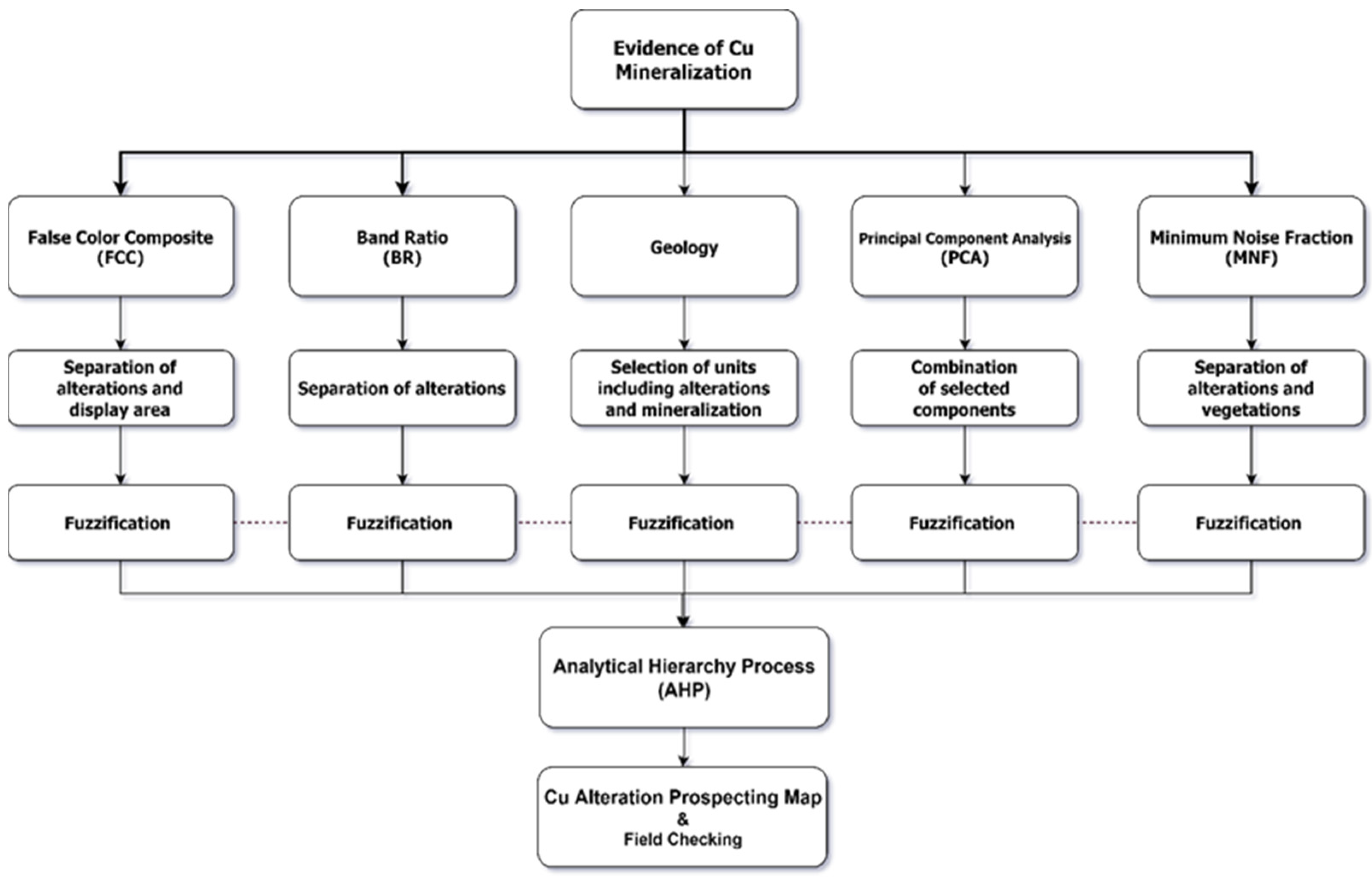
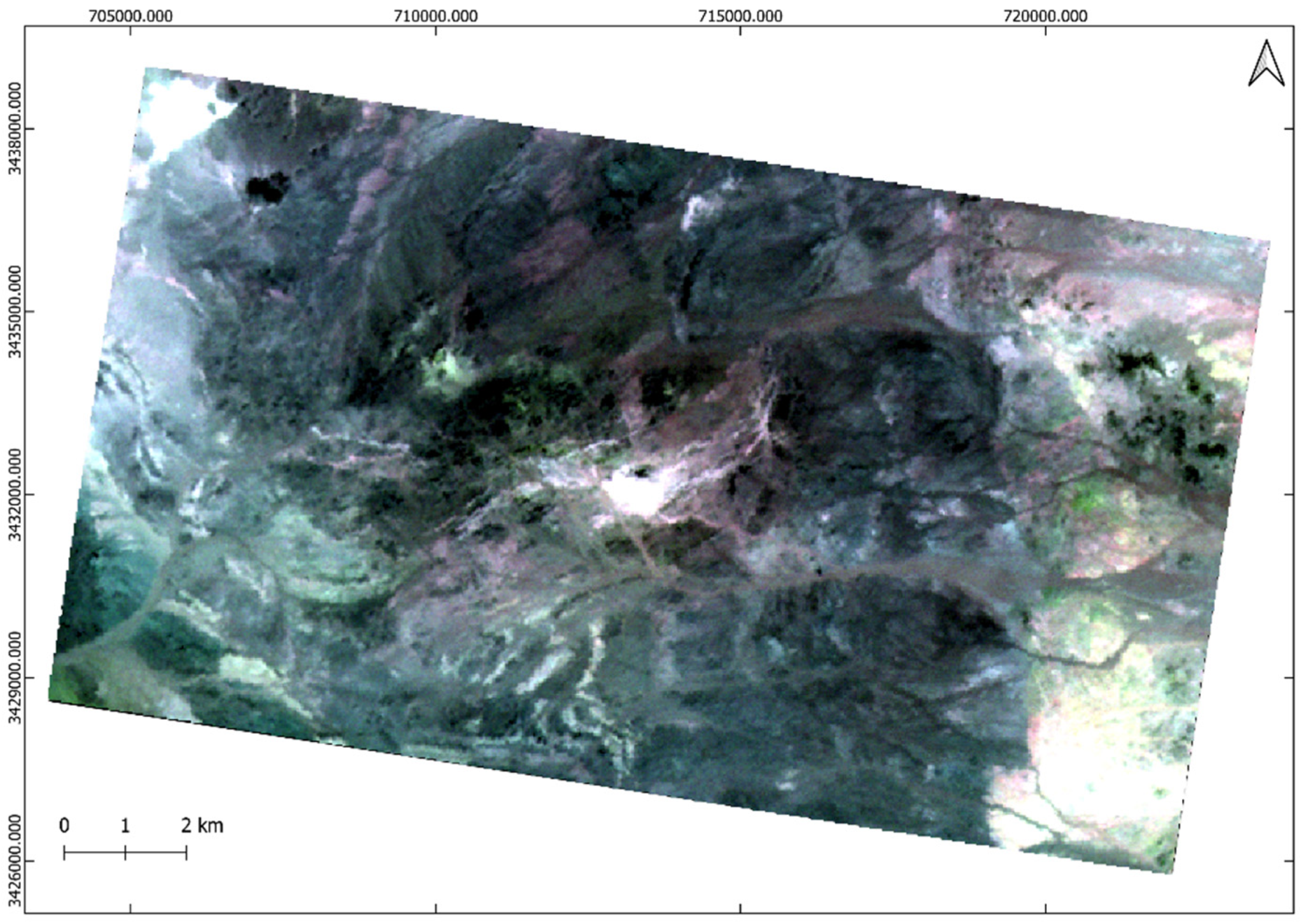
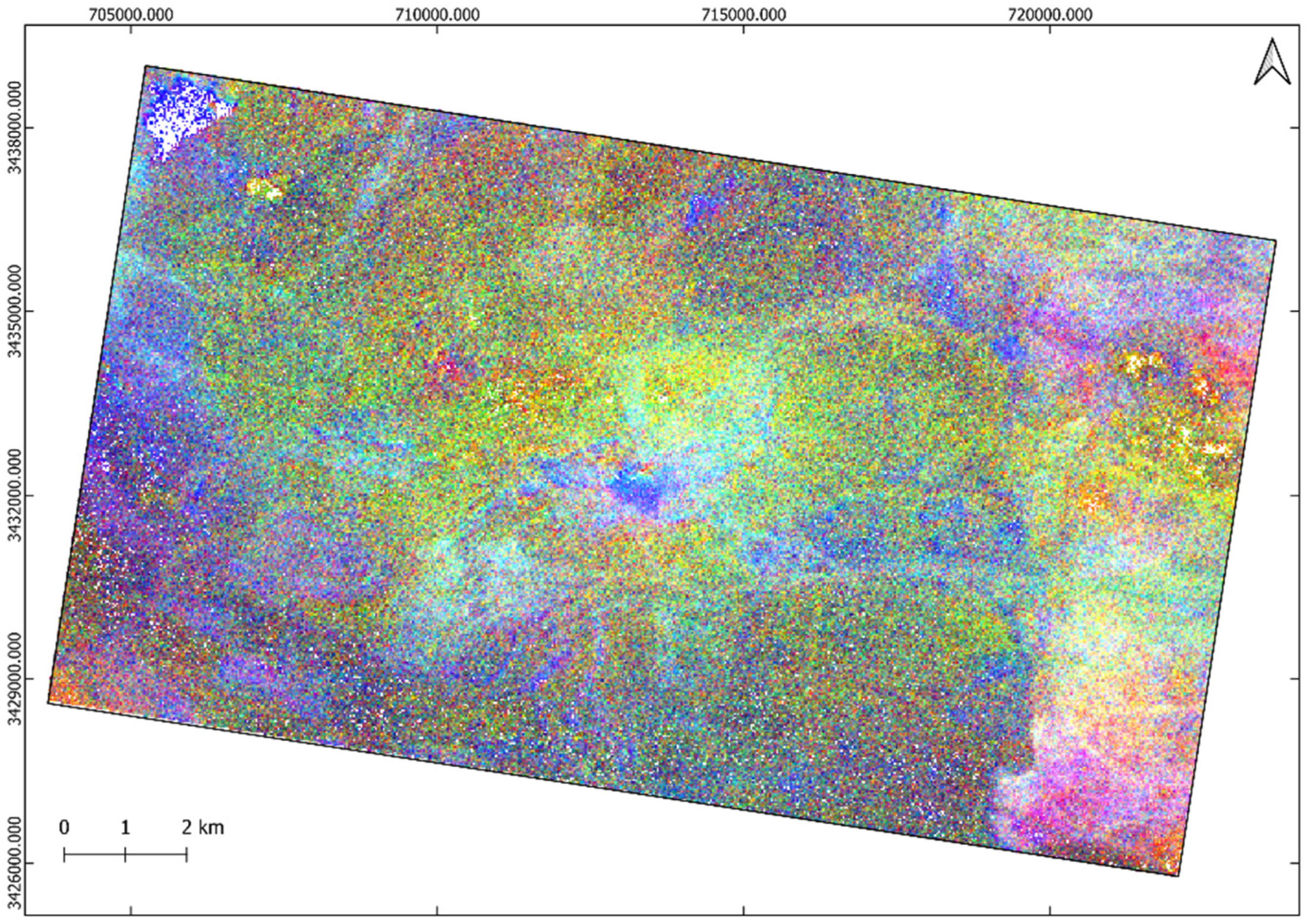
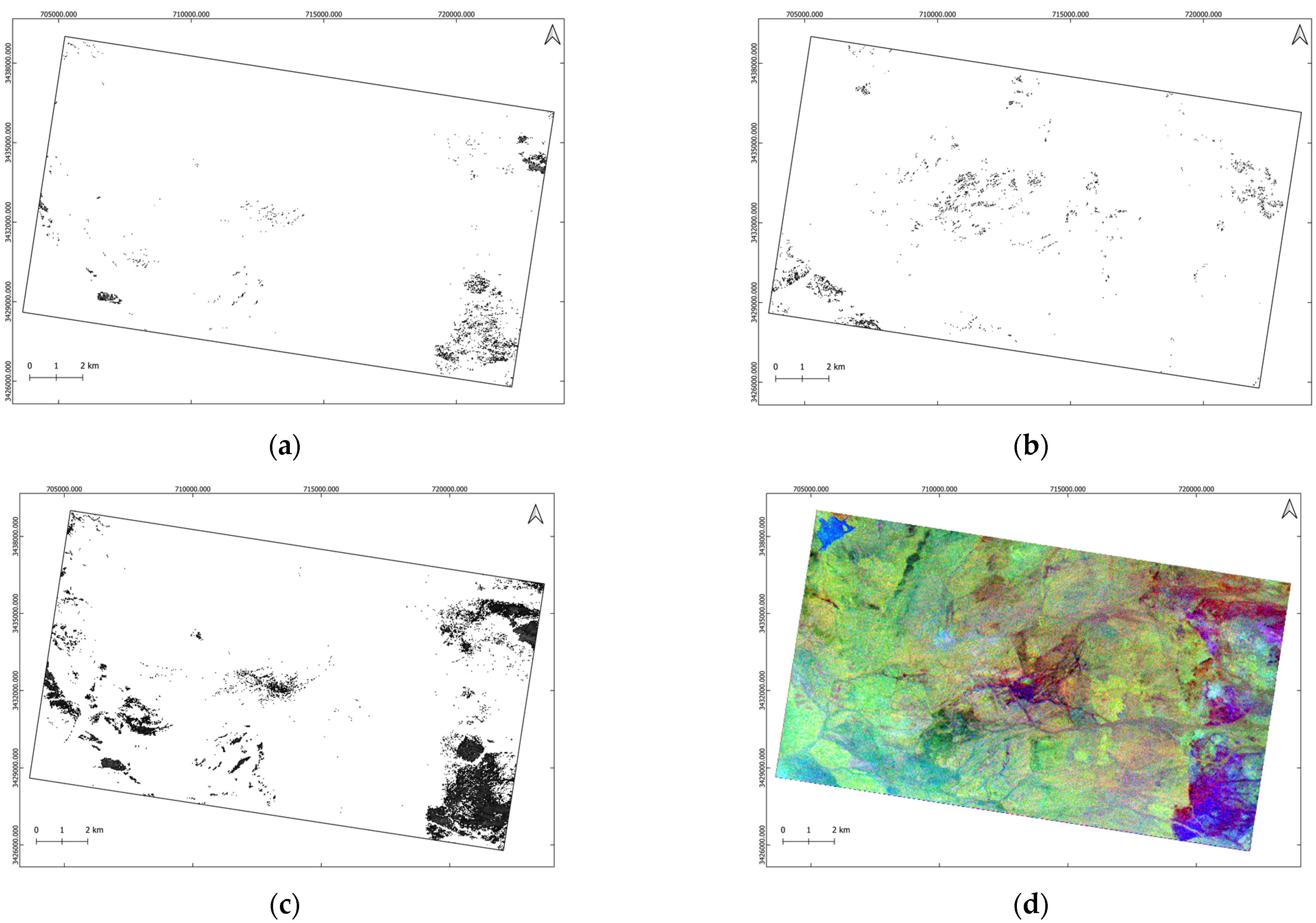
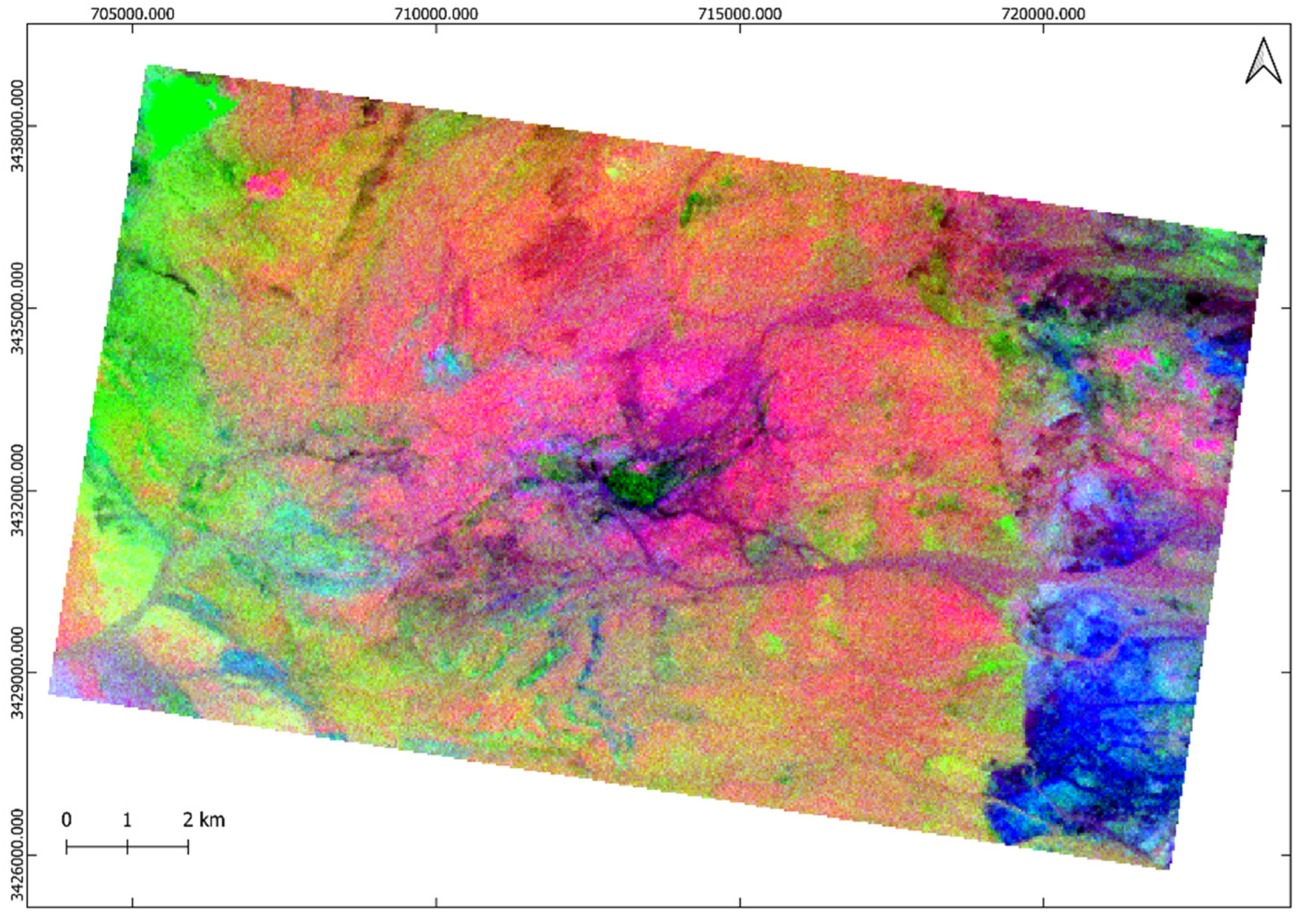

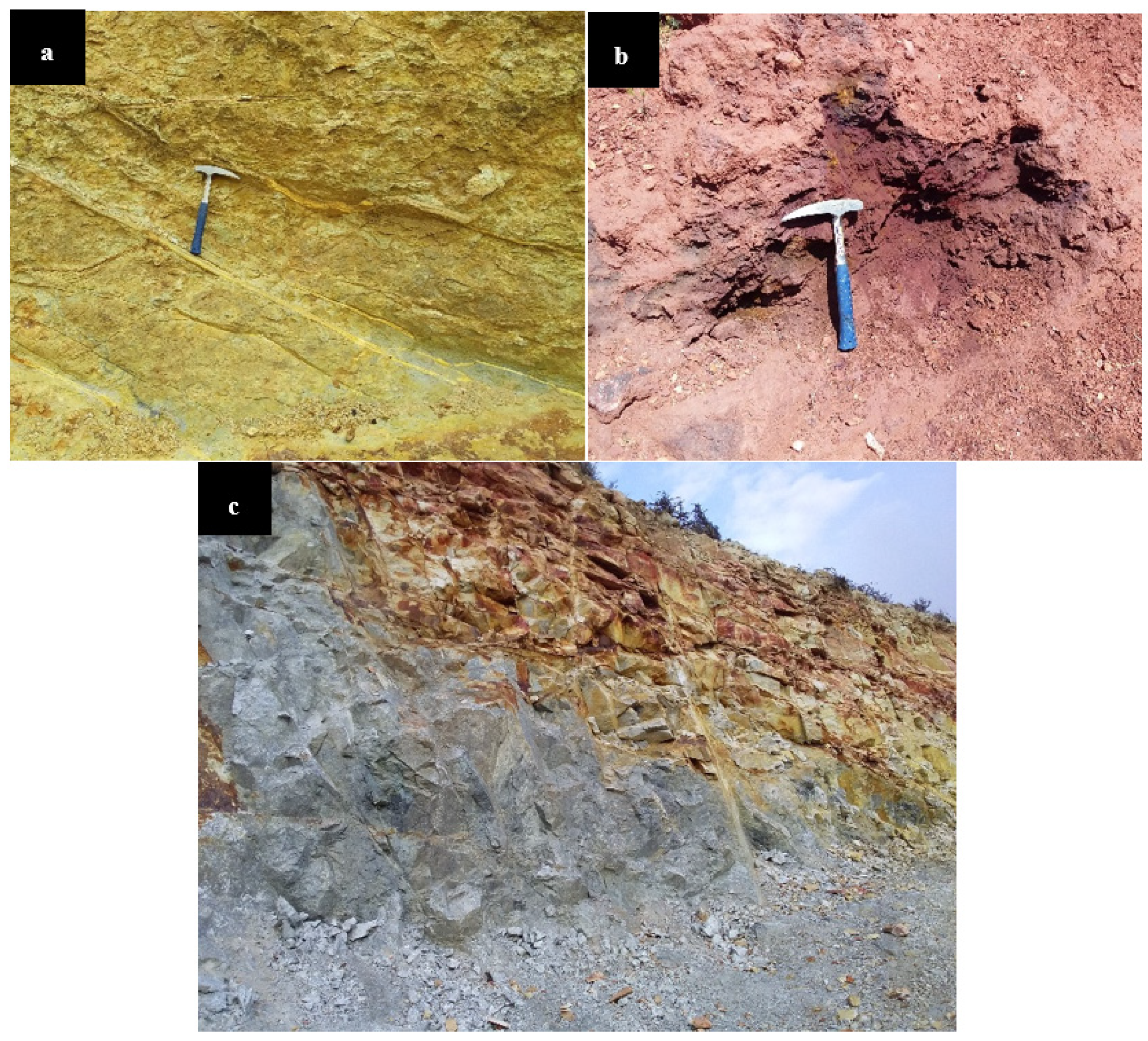
| Band | Reflected Range (µm) | Spatial Resolution (m) | Band | Reflected Range (µm) | Spatial Resolution (m) |
|---|---|---|---|---|---|
| 1 | 0.52–0.60 | 15 m | 8 | 2.295–2.365 | 30 m |
| 2 | 0.63–0.69 | 15 m | 9 | 2.360–2.430 | 30 m |
| 3N | 0.78–0.86 | 15 m | 10 | 8.125–8.475 | 90 m |
| 3B | 0.78–0.86 | 15 m | 11 | 8.475–8.825 | 90 m |
| 4 | 1.600–1.700 | 30 m | 12 | 8.925–9.275 | 90 m |
| 5 | 2.145–2.185 | 30 m | 13 | 10.25–10.95 | 90 m |
| 6 | 2.185–2.225 | 30 m | 14 | 10.95–11.65 | 90 m |
| 7 | 2.235–2.285 | 30 m |
| PCs | 1st Band | 2nd Band | 3rd Band | 4th Band | 5th Band | 6th Band | 7th Band | 8th Band | 9th Band | Eigenvalue (%) |
|---|---|---|---|---|---|---|---|---|---|---|
| PC1 | 0.331 | 0.334 | 0.335 | 0.332 | 0.33 | 0.338 | 0.339 | 0.333 | 0.337 | 91.6 |
| PC2 | 0.321 | 0.26 | 0.264 | 0.215 | 0.195 | 0.143 | −0.457 | −0.472 | −0.470 | 5.6 |
| PC3 | −0.764 | −0.036 | 0.104 | 0.059 | −0.251 | 0.563 | 0.02 | 0.129 | 0.031 | 1.1 |
| PC4 | 0.108 | −0.415 | 0.492 | 0.61 | 0.283 | −0.348 | 0.015 | −0.672 | 0.205 | 0.94 |
| PC5 | −0.170 | −0.305 | 0.265 | 0.519 | −0.283 | −0.101 | 0.119 | 0.04 | 0.319 | 0.42 |
| PC6 | 0.024 | −0.541 | 0.064 | −0.162 | 0.23 | 0.159 | −0.205 | −0.224 | −0.407 | 0.19 |
| PC7 | 0.268 | 0.027 | 0.162 | 0.641 | −0.381 | 0.101 | −0.219 | −0.047 | 0.013 | 0.09 |
| PC8 | −0.041 | −0.261 | 0.207 | 0.3 | 0.06 | −0.291 | 0.262 | −0.670 | 0.435 | 0.04 |
| PC9 | 0.292 | −0.026 | −0.076 | −0.163 | 0.258 | 0.317 | 0.152 | −0.320 | 0.168 | 0.02 |
| MNF Band | Eigenvalue | Variance (%) |
|---|---|---|
| 1 | 82.3 | 81.7 |
| 2 | 8.54 | 8.48 |
| 3 | 5.41 | 5.37 |
| 4 | 1.66 | 1.65 |
| 5 | 1.51 | 1.5 |
| 6 | 1.31 | 1.3 |
| Geology | PCA | MNF | BR | FCC | |
|---|---|---|---|---|---|
| Geology | 1 | 5 | 3 | 3 | 2 |
| PCA | 0.2 | 1 | 3 | 2 | 2 |
| MNF | 0.33 | 0.33 | 1 | 4 | 2 |
| BR | 0.33 | 0.5 | 0.25 | 1 | 1 |
| FCC | 0.5 | 0.5 | 0.5 | 1 | 1 |
| Priority | Rank | |
|---|---|---|
| Geology | 43.40% | 1 |
| PCA | 20.90% | 2 |
| MNF | 16.60% | 3 |
| FCC | 10.60% | 4 |
| BR | 8.60% | 5 |
Publisher’s Note: MDPI stays neutral with regard to jurisdictional claims in published maps and institutional affiliations. |
© 2021 by the authors. Licensee MDPI, Basel, Switzerland. This article is an open access article distributed under the terms and conditions of the Creative Commons Attribution (CC BY) license (https://creativecommons.org/licenses/by/4.0/).
Share and Cite
Khosravi, V.; Shirazi, A.; Shirazy, A.; Hezarkhani, A.; Pour, A.B. Hybrid Fuzzy-Analytic Hierarchy Process (AHP) Model for Porphyry Copper Prospecting in Simorgh Area, Eastern Lut Block of Iran. Mining 2022, 2, 1-12. https://doi.org/10.3390/mining2010001
Khosravi V, Shirazi A, Shirazy A, Hezarkhani A, Pour AB. Hybrid Fuzzy-Analytic Hierarchy Process (AHP) Model for Porphyry Copper Prospecting in Simorgh Area, Eastern Lut Block of Iran. Mining. 2022; 2(1):1-12. https://doi.org/10.3390/mining2010001
Chicago/Turabian StyleKhosravi, Vahid, Aref Shirazi, Adel Shirazy, Ardeshir Hezarkhani, and Amin Beiranvand Pour. 2022. "Hybrid Fuzzy-Analytic Hierarchy Process (AHP) Model for Porphyry Copper Prospecting in Simorgh Area, Eastern Lut Block of Iran" Mining 2, no. 1: 1-12. https://doi.org/10.3390/mining2010001
APA StyleKhosravi, V., Shirazi, A., Shirazy, A., Hezarkhani, A., & Pour, A. B. (2022). Hybrid Fuzzy-Analytic Hierarchy Process (AHP) Model for Porphyry Copper Prospecting in Simorgh Area, Eastern Lut Block of Iran. Mining, 2(1), 1-12. https://doi.org/10.3390/mining2010001










